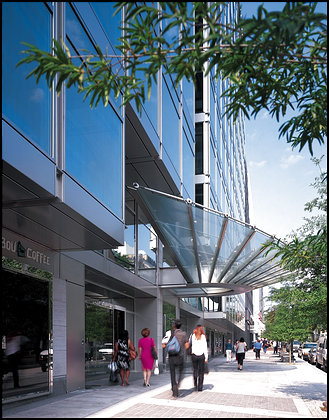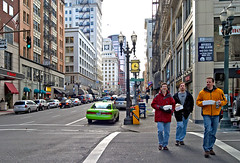1700 K Street NW
 Photo by Maxwell MacKenzie. Retail front, 1700 K Street NW.
Photo by Maxwell MacKenzie. Retail front, 1700 K Street NW.Ben Forgey waxes poetic about another glass box in "Corner Kick: An Architect Scores With an Elegant Office Building at A Key Intersection." Urban planning consultant (and ex-DC city planner) Konrad Perlman's response is a lot more pointed and more focused on urban design, rather than the "art" of the building. Check out Konrad's blog entry here.
Another counter-entry would be the piece "One Happy Big-Box Wasteland Oh my yes, there is indeed one force that is eating away the American soul like a cancer," in the San Francisco Chronicle, where the writer criticizes the sameness of a built environment developed around automobility and consumerism. Where he was talking about cookie cutter developments with then same stores, every 10 miles or so, the points he makes about the impact of this on us as people are no less relevant to the sameness of office gulches along K Street NW or M Street SE in Washington, DC.
Mark Moford writes:
Result No. 1: Towns no longer have personality, individuality, heart. Community drags. Environment suffers. Our once diverse and quirky and idiosyncratic landscape becomes ugly and bland and vacuous and cheap.
Result No. 2: a false sense of safety, of comfort, wrought of empty sameness. We want all our goods to be antiseptic and sanitized and brightly lit and clean. In a nation that has lost all sense of direction and all sense of pride and whose dollar is a global joke and whose economy is running on fumes and whose goods are all made overseas and whose incompetent warmongering leader makes the world gag, that toxic sameness is, paradoxically, reassuring.
Result No. 3: We are trained, once again, to fear the different, the Other, That Which Does Not Conform. We learn to dislike the unique, the foreign, foreigners. We lose any sense of personal connection to what we create and what we buy and I do not care how cheap that jute rug from Ikea was: When they are mass-produced in 100,000 chunks in a factory in Malaysia, it ain't quirky.
Sameness is in. Sameness is the new black...
_______________
The real problem with big office buildings
About a year ago, when I was trying to start a Jane Jacobs reading group, someone sent me an email that said the real problem with DC is that it is an "immature" city unlike NYC. I countered that no, what happened was that in the reconstruction of the downtown business district over the past 30 years, where there were many small office buildings on each face block of a square--maybe one block had 10 buildings--each with an entrance--today's pattern puts 2-4 very large office buildings on an entire square with 2-8 entrances on four sides of the square, rather than 30 or more entrances (or people magnets) spread across the entire square.
As a result, pedestrians are channeled in very particular ways, and the interior of many blocks have become dead zones. This is one of the reasons that retail is weak downtown. Downtown buildings are pretty monocultural and the feeling isn't much different than a shopping mall, albeit more like the Galleria in Houston, where office, shopping, and hotel (soon with housing) are combined into one large sprawl.
Unfortunately, I don't have any good scans of "old" downtown DC photos that illustrates this, although there are plenty of images in such books as Capital Losses and Peter Penczer's Washington: Past and Present.
The image below, from Portland Oregon this past January, illustrates the point.
 Image from www.portlandground.com
Image from www.portlandground.com



0 Comments:
Post a Comment
<< Home